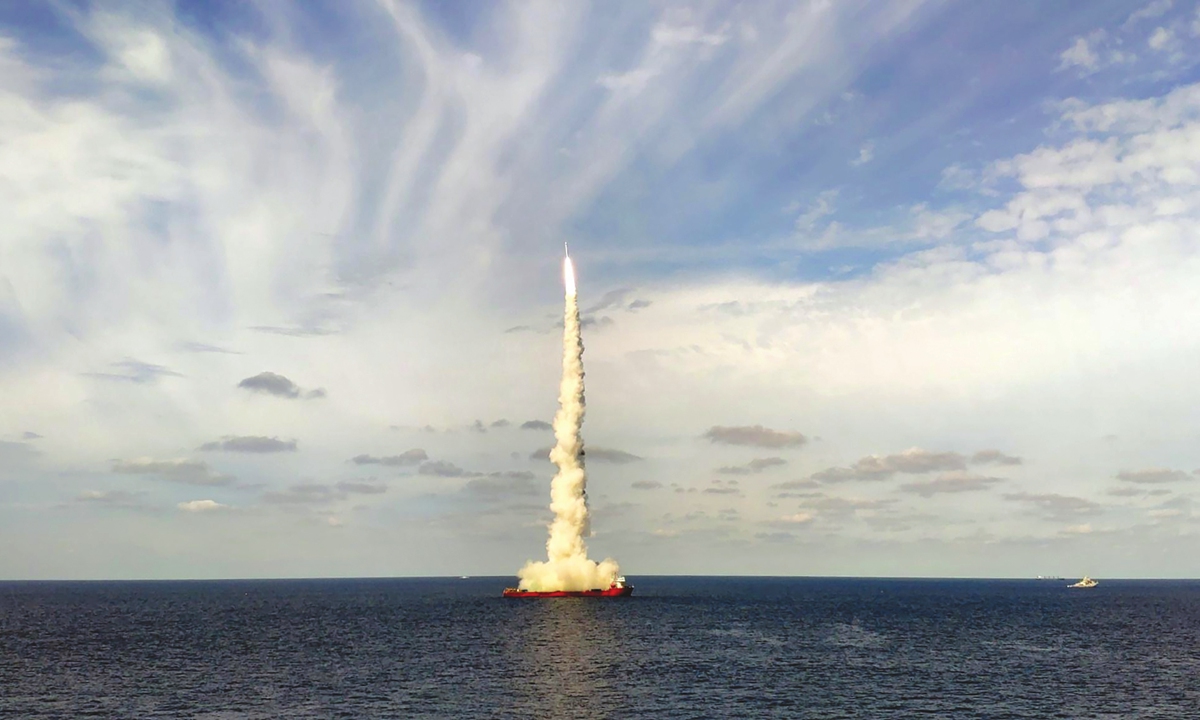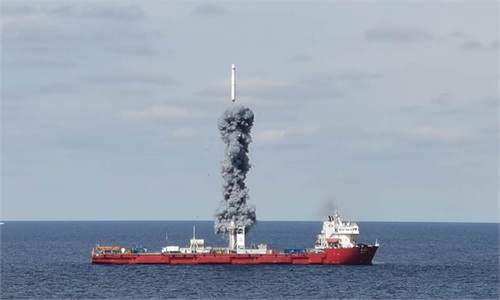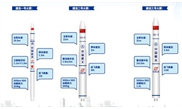GT exclusive: China's first integrated base supporting rocket building, sea launch to be 'operational in May'

A Long March-11 solid-propellant light launch vehicle lifts off from a mobile floating platform in the Yellow Sea off the coast of East China's Shandong Province. Photo: VCG
China's new rocket base specially designed to support seaborne rocket launches, located in the coastal city of Haiyang, East China's Shandong Province, will become operational in May, and it will be capable of general assembly and testing for at least 10 solid-propellant rockets per year, a project leader disclosed to the Global Times on Tuesday.
The base's capacity will increase to 20 rockets per year by October 2022, Li Shaoning, deputy chief engineer with the project developer - rocket manufacturer China Rocket Co, under state-owned space giant China Academy of Launch Vehicle Technology (CALT) - told the Global Times during an exclusive interview on Tuesday.
Li, also general manager of the subsidiary, revealed to the Global Times that the Haiyang base would serve particularly the launch missions of Smart Dragon rocket series and the Long March 11 at sea.
According to Li, Smart Dragon-1, which can send a payload of 200 kilograms into a 500-kilometer Sun-synchronous orbit with a launch cost of $20,000 per kilogram - around 60 percent of that for foreign commercial rocket launches of a similar scale - is working on the roll-out of a sea launch version.
The Smart Dragon-3 solid-fuel launch vehicle, which is capable of sending up to 20 satellites in one go, has gained project approval and is expected to make its maiden flight in 2022, the Global Times previously reported.
Smart Dragon-3 will be also available for sea launch missions, he said.
The project aims to normalize China's seaborne launches in a highly efficient and integrated manner, which will combine the country's aerospace and maritime technologies and boost local industries such as smart manufacturing, logistics and new materials.
Compared with traditional inland bases, the Haiyang site would streamline the general assembly and pre-launch testing work, and save time spent on rocket de-assembly and transfer.
An agreement for the project, which is planned to cover 18.6 square kilometers with a total investment of 23 billion yuan ($3.5 billion), was signed by CALT and the city government of Yantai, which administers Haiyang.
It will consist of support facilities for sea-based space missions, four research and production centers for carrier rockets, satellite equipment, sea-launch platforms, and satellite data and applications.
The base would be able to improve China's sea-launch efficiency by 10-15 days, while providing better risk management, Li noted.
Thanks to its unique location, climate, and industrial base - in addition to existing harbors and local space research and marine engineering facilities - Haiyang has become China's only space launch center that meets both rocket manufacturing and launching conditions.
Rockets rolled out from the manufacturing base can directly perform launches, integrating the processes of production, manufacturing and launching in one spot.
Compared with conventional land-based launches, seaborne launches, although more difficult, are much safer because they avoid the risk of rocket debris falling onto densely populated areas, space analysts told the Global Times.
China has conducted two successful seaborne launches, with the latest one in September last year, when a Long March-11 solid propellant light launch vehicle lifted off from a mobile floating platform in the Yellow Sea off the coast of Shandong.
During the second attempt, developers optimized and streamlined its sea launch capabilities by deploying a new launch vessel and putting a new coastal spaceport into operation.
China's first sea-based launch was carried out in June 2019, also with a Long March-11 carrier rocket, on a large semi-submersible barge in the Yellow Sea, which marked a breakthrough in the safety, stability and reliability of launches at sea despite complicated marine environments.



